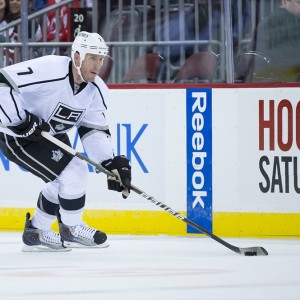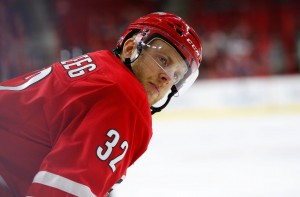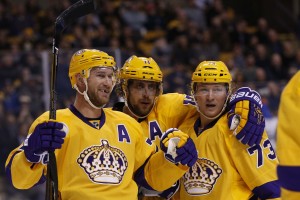Another trade deadline has come and gone, and the Los Angeles Kings again refused to be passive bystanders. Of course, they didn’t shock the world this year, and bring in any high-priced dynamos to raise the team’s energy level like a triple expresso shot. The Kings didn’t have to do that this year, given their overall record and the amount of good-to-great talent on the roster.
But make no mistake about it, moves were needed. The Kings have been bitten by the dreaded injury bug, with several players missing stretches of action that varies from one game to the chilling distinction of “long term injured reserve.” They’ve also had a few players fail to live up to expectations, creating an undesirable gap between performance and their overall championship goal. If the Kings mission was to make the playoffs, potentially win a round or two, and build towards the future, everything would have been fine in Sutter-land. Fortunately for L.A. fans, this club only has visions of Lord Stanley’s trophy dancing in their heads.
And with hockey’s biggest prize firmly ingrained in their organizational mantra, the Kings went to work well before the February 29th trade deadline. Multiple areas needed to be addressed, and they were. Let’s start with the L.A.’s most blatantly obvious weakness:
Strengthening the Blue Line
Outside of “Lakers coaching” and “Clippers general likeability,” nothing was harder to support at the Staples Center than the Kings initial defensive core. Drew Doughty continues to evolve as one of the league’s best, and the trio of Jake Muzzin, Alec Martinez, and Brayden McNabb all have shown tremendous improvement as this season’s progressed. Still, four quality defenseman is not enough, even with an extraterrestrial like Doughty. Which is why two of the three main deals the Kings made revolved around the blue line, as they searched for a means to create depth and overall defensive flexibility through the trade market.
What is defensive flexibility? It’s simple really. Each defensive core contains six spots (seven on the rarest of occasions). The top four will play the majority of even-strength time, while the specialty roles will be filled based on the individual skill-sets of each defenseman. Now the Kings have a true workhorse in Doughty, an array of offensive skill and exceptional fundamentals in the “M trio” (will that nickname stick? I hope it does). So in acquiring a pair of defensemen, the Kings wanted to also remain flexible. The offensive side is there, as is the youth factor (all of the top four are under 30). The L.A. blue line needed toughness, grit, and intelligence to round out the unit.
The first domino dropped in a January deal that centered around Luke Schenn. As I covered earlier, the young defenseman was caught between a numbers game and heightened expectations in Philadelphia. In L.A., he doesn’t need to be a top four piece, just a reliable option every night. And that’s what Schenn has been, playing solid, albeit not standout hockey for the Kings. What he lacks in offensive production, he certainly makes up for in little areas such as shot blocking and hitting.
The other thing Schenn isn’t doing is screwing up massively, or costing his team goals with ill-advised decision-making. It sounds funny to say, but in a league with as much frightening talent as the NHL, sometimes just being competent at your job is good enough. Compared to the other options the Kings were forced to parade out each night, Schenn has turned the Nathan’s 4th of July Hot Dog contest into the Victoria’s Secret Fashion Show.
After Schenn was acquired and had capably proved himself, Kings general manager Dean Lombardi had five solid defensemen.
That’s a decent amount for most teams, but he wanted six. Lombardi decided to do a borderline treasonous act, by becoming trading partners with (dun dun dun…) Chicago! Gasps and fainting aside, no team is outside your web of contacts if they can help make your franchise better. The ensuing discussion led to L.A. shipping out defenseman Christian Ehrhoff, who struggled mightily since signing with the club last off-season, in exchange for fellow d-man Rob Scuderi. Lombardi had made a deal with the devil, and he had done so to acquire a name all too familiar in the City of Angels.

Scuderi was a bit of a cult hero on the Kings first Cup run in 2011-12, partnering with Doughty and really showing him the ropes of being a professional athlete. He may be 37 years old and at the twilight of his NHL career, but the Kings are simply looking for solid play to round out their defensive rotation. They simply weren’t getting that from Ehrhoff, and to be fair, the Blackhawks (and before that, the Penguins) weren’t getting it either from Scuderi. Sometimes a change of scenery can serve as a fountain of youth. Especially, in Scuderi’s case, when it’s a road once traveled before.
When looking for the sixth defenseman in your lineup, a couple of things come in mind. First of all, you need to play the position with a defense-first mindset (“I’m not here to score goals, my top priority is keeping the puck out of my net”). The second thing you need is to provide toughness and a willingness to stand up for yourself and your teammates. And the third quality is the absence of an ego. Ice time will be infrequent, and on occasion (such as in the playoffs), nonexistent. Accepting your role can be difficult, which is why it takes a true professional such as Scuderi to accept the task at hand. If there’s one clip that summarizes it all, it’s this altercation with the Flyers Jakub Voracek:
Voracek might have got a few lucky punches in, but Scuderi has to still feel like he won the fight (kidding, obviously). The play was textbook Rob Scuderi. Make a hit, refuse to back down, stand up for yourself, and then regroup for whatever the team asks of you on your next shift. I think he’ll fair quite well on the Kings.
Veteran Forward Depth
The Kings were willing to take on additional contract in the Schenn trade, which happened to be former All-star Vinny LeCavalier. Starting out as a financial chip to make the deal work (he actually agreed to retire at season’s end as part of the trade), LeCavalier shockingly has produced moderate numbers. With nine points in 23 games, the elder “skatesman” of the Kings forward group has given his squad some solid depth where it was lacking. The Kings have several forwards who are young, physical, and play more of a straight-ahead style on lines three and four, but LeCavalier provides them with knowledge and intellect where his legs can no longer take him. And given the puck possession gameplan that head coach Darryl Sutter deploys, I can’t think of a better situation for the aging veteran.
Don’t expect LeCavalier to morph into his 24-year-old self and party like it’s 2004. Sadly, the days of him dominating key stretches of a game are long gone. But this older version of LeCavalier can still be a factor on a championship team.
The Fill-In Gamer
The final trick up Lombardi’s sleeve was acquiring significant offense to replace the production lost through the injury to Marian Gaborik. Finding a capable forward can be tricky, especially when you are as dangerously close to the salary cap edge as the Kings were. But Lombardi delivered, and he acquired Kris Versteeg from the Carolina Hurricanes. Versteeg is two things: a proven winner (2 Stanley Cups with Chicago) and a human suitcase (now traded seven times in his career). He’s 29 years old, and has produced fairly well in Carolina this season (11 goals, 33 points) in spite of that franchise’s decision to discard as many veterans and salary albatrosses as possible.

There’s certainly a high level of optimism that Versteeg can fill in for Gaborik and provide an additional scoring punch. Versteeg is used to playing with all-world talent such as Patrick Kane and Jonathan Toews, so the transition to this star-studded roster should be smoother than it would be for most. When you play with superstars, you have to get used to playing without the puck. You have to use your instincts to put yourself in the right positions to help your team, and eventually, to score goals. Versteeg can do just that, as depicted on this beautiful goal:
Flashy finish aside, Versteeg got positioning on one of the best defenseman in the NHL (Washington’s John Carlson), and found himself on the doorstep at precisely the right time. It seems easy enough, but a lot of quality forwards don’t give themselves this opportunity.
Then of course, there is Versteeg’s determination. It takes a lot of resolve to pack up and begin playing on a new team, especially when it involves leaving a budding dynasty such as the Blackhawks. But Versteeg has taken each trade in stride, and produced everywhere he has gone. His stats will never be confused with those of a superstar, because that’s not who is. A glorified grinder? Perhaps. But all goals count the same, and none demonstrates Versteeg’s obsessive work ethic like this one:
https://www.youtube.com/watch?v=CMrKw6jgHso
Once he takes his initial shot, Versteeg is hell-bent on following the puck to the net. He never stops moving, and he never stops tracking the puck with his eyes. I’d expect Versteeg to get some opportunities on the Kings top two offensive lines, and certainly some power play time. History’s proven that he’s worth the low risk the Kings have taken.
Trusting Your Players

Maybe the biggest storyline is that Lombardi didn’t drastically shake up his roster at the trade deadline. The team is still led by the same core, and paced by the elite offensive and defensive weapons that have raised banners in the past. It would be easy to freak out at the sudden rise of the Anaheim Ducks, or the resurgent play of the San Jose Sharks, and try to calm some nerves by throwing money at the situation. Every team goes through slumps, and every team surges. The Kings believe that with their roster, and a few added pieces, they can be just fine when the games matter the most.
Last season the Kings were antsy at the trade deadline, and decided to sacrifice a first round pick on a player that would prove to be a rental (Andrej Sekera, now on the Oilers). Lombardi took a different approach this year, one that he hopes will pay dividends both this April and well into the end of this decade. It wasn’t a flashy trade deadline, but it served the purpose that all deadlines are subsequently evaluated by. The Kings made themselves better, but by how much? Tune in to find out.